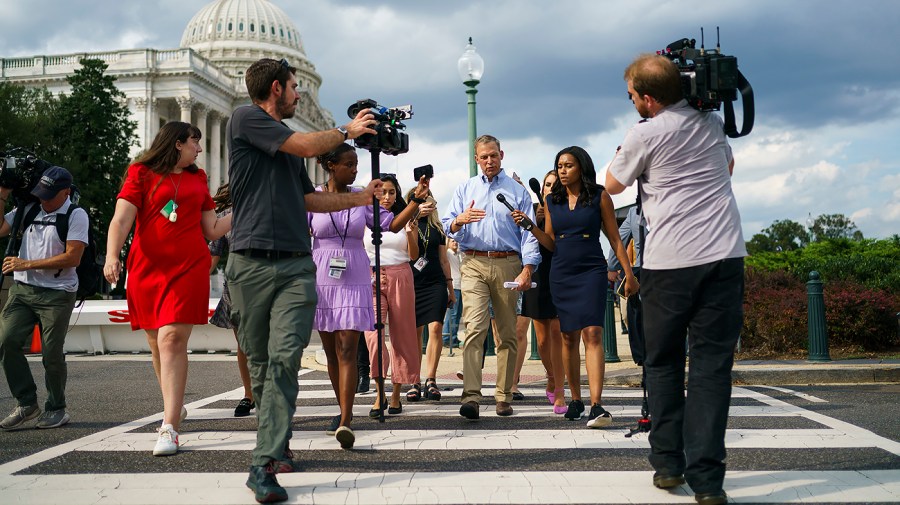Business
Spending deal that helped sink McCarthy sees new hope as conservatives ease up on December 5, 2023 at 11:05 am Business News | The Hill

After months of infighting, bruising failed floor votes and the historic ouster of their leader, House Republicans could end up falling back on a bipartisan debt ceiling deal struck by former Speaker Kevin McCarthy (R-Calif.) earlier this year that helped lead to his undoing.
The agreement, brokered by the White House and GOP leadership, appears to be seeing the greatest glimmers of hope since its passage in the spring, as hard-line conservatives soften demands for cuts steeper than those laid out in the compromise.
“Basically, they agreed to what we had said all along, that the numbers that the Speaker agreed to with the president were the numbers that are set and the numbers we should live by,” Rep. David Joyce (R-Ohio), a spending cardinal on the House Appropriations Committee, told The Hill.
House Republicans have repeatedly clashed this year over spending, as the right flank pressured GOP leadership to take a more aggressive stance on spending levels in the conference’s 12 annual government funding bills.
The strategy was to achieve the most conservative starting position possible ahead of eventual negotiations with Senate Democrats. But as the House GOP struggles to unify behind its five remaining funding bills, some in the right flank are letting up on their push for significantly lower funding levels, which they acknowledge is no longer achievable.
Rep. Scott Perry (R-Pa.), head of the ultraconservative House Freedom Caucus, said last week that the $1.59 trillion discretionary spending level set as part of the Fiscal Responsibility Act (FRA) for fiscal 2024 needed to be accepted as “the limit” in bicameral spending negotiations.
While he said the number is still “too high” for the caucus, his comments come as the group is pressing for both chambers to begin to conference their drastically different batch of funding bills as soon as possible, particularly as Congress stares down another government shutdown deadline in January.
“We never agreed to this number, but we understand that, right now, we’re in peril of actually being at like $1.8 [trillion] as opposed to $1.59 [trillion],” he argued Friday, while taking aim at the Senate over “additional packages” the upper chamber could pass in the weeks ahead as it considers aid for Israel and Ukraine.
“So, we’re just saying, look, you already voted for $1.59 [trillion] in FRA. That’s the limit,” Perry said.
While the caucus’s shift on the issue has drawn attention in the past week, some in the conference view the change in tone as a long time coming.
“This is where I always thought we would end up,” Rep. Tom Cole (R-Okla.), another spending cardinal, said. “So, I’m not surprised that they understood that something that both houses had passed and the president signed was probably going to be the deal.”
The House Freedom Caucus had pushed for a top line of $1.47 trillion for the conference’s starting position ahead of bipartisan talks with the Senate, while sharply criticizing the budget deal struck by McCarthy as part of a larger agreement to raise the debt ceiling.
Members of the caucus repeatedly used hard-line tactics on the floor to pressure leadership for steeper cuts to the party’s funding bills, before some in the right flank touted an internal agreement from leadership in September to craft the party’s spending bills to a top-line level of about $1.526 trillion.
But tensions hit a fever pitch later that month, just as government funding was also set to run out, as McCarthy struggled to pass legislation to keep the lights on amid internal disagreements on spending.
Despite the add-ons to the GOP-proposed stopgap bill that called for immediate cuts and border policy changes intended to sweeten the pot for conservatives, the measure failed to gain adequate support from the conference.
That led McCarthy to bring up a bipartisan stopgap in the eleventh hour that averted a shutdown — but also helped cost him his job.
The conference eventually passed several more of its annual spending bills under the leadership of Speaker Mike Johnson (R-La.).
But Republicans face serious hurdles to passing their remaining spending bills, which include some of the party’s biggest proposed cuts to nondefense programs, amid divisions over spending and thorny policy riders on issues such as abortion.
At the same time, senators have also been held up passing their government funding bills as lawmakers have been working to strike an ambitious deal on a supplemental funding package that could include aid for Israel and Ukraine, as well as what Republicans hope are changes to border policy.
As the annual appropriations work stalls in both chambers, lawmakers are hoping for a bicameral top-line agreement soon to kickstart bipartisan spending talks.
Cole, who heads the subcommittee that oversees funding for the Department of Transportation, said Friday that he’s expecting to hear from GOP leadership this week on what top lines could look like in talks, as well as other issues such as rescissions.
Earlier this year, Biden administration officials said the bipartisan debt limit agreement reached in May also included a handshake deal to pull back $20 billion in IRS funding that Democrats approved in the last Congress, with the purpose of reinvesting those funds into discretionary funding for nondefense programs.
While hard-line conservatives have let up in their demands for spending below the budget caps agreed to by McCarthy and President Biden, Perry and others have already spoken out against rescissions to yank back old funding to offset spending elsewhere.
“It’s still spending. When you add it up, the dollars that go out, have got to equal some number,” Rep. Ralph Norman (R-S.C.) said. “You can’t plus it back up. That includes the supplementals and the rescissions.”
While Cole called rescissions a “normal tool” in Congress, he also said “whatever agreement was had was the agreement with Speaker McCarthy” and that he doesn’t see the current Speaker as “bound by it.”
“It’s up to him, but we’ll work with whatever number and with whatever tools the current Speaker thinks is more appropriate,” Cole said.
House, Business, News After months of infighting, bruising failed floor votes and the historic ouster of their leader, House Republicans could end up falling back on a bipartisan debt ceiling deal struck by former Speaker Kevin McCarthy (R-Calif.) earlier this year that helped lead to his undoing. The agreement, brokered by the White House and GOP leadership, appears…
Business
Harvard Grads Jobless? How AI & Ghost Jobs Broke Hiring

America’s job market is facing an unprecedented crisis—and nowhere is this more painfully obvious than at Harvard, the world’s gold standard for elite education. A stunning 25% of Harvard’s MBA class of 2025 remains unemployed months after graduation, the highest rate recorded in university history. The Ivy League dream has become a harsh wakeup call, and it’s sending shockwaves across the professional landscape.

Jobless at the Top: Why Graduates Can’t Find Work
For decades, a Harvard diploma was considered a golden ticket. Now, graduates send out hundreds of résumés, often from their parents’ homes, only to get ghosted or auto-rejected by machines. Only 30% of all 2025 graduates nationally have found full-time work in their field, and nearly half feel unprepared for the workforce. “Go to college, get a good job“—that promise is slipping away, even for the smartest and most driven.
Tech’s Iron Grip: ATS and AI Gatekeepers
Applicant tracking systems (ATS) and AI algorithms have become ruthless gatekeepers. If a résumé doesn’t perfectly match the keywords or formatting demanded by the bots, it never reaches human eyes. The age of human connection is gone—now, you’re just a data point to be sorted and discarded.
AI screening has gone beyond basic qualifications. New tools “read” for inferred personality and tone, rejecting candidates for reasons they never see. Worse, up to half of online job listings may be fake—created simply to collect résumés, pad company metrics, or fulfill compliance without ever intending to fill the role.
The Experience Trap: Entry-Level Jobs Require Years
It’s not just Harvard grads who are hurting. Entry-level roles demand years of experience, unpaid internships, and portfolios that resemble a seasoned professional, not a fresh graduate. A bachelor’s degree, once the key to entry, is now just the price of admission. Overqualified candidates compete for underpaid jobs, often just to survive.
One Harvard MBA described applying to 1,000 jobs with no results. Companies, inundated by applications, are now so selective that only those who precisely “game the system” have a shot. This has fundamentally flipped the hiring pyramid: enormous demand for experience, shrinking chances for new entrants, and a brutal gauntlet for anyone not perfectly groomed by internships and coaching.
Burnout Before Day One
The cost is more than financial—mental health and optimism are collapsing among the newest generation of workers. Many come out of elite programs and immediately end up in jobs that don’t require degrees, or take positions far below their qualifications just to pay the bills. There’s a sense of burnout before careers even begin, trapping talent in a cycle of exhaustion, frustration, and disillusionment.
Cultural Collapse: From Relationships to Algorithms
What’s really broken? The culture of hiring itself. Companies have traded trust, mentorship, and relationships for metrics, optimizations, and cost-cutting. Managers no longer hire on potential—they rely on machines, rankings, and personality tests that filter out individuality and reward those who play the algorithmic game best.
AI has automated the very entry-level work that used to build careers—research, drafting, and analysis—and erased the first rung of the professional ladder for thousands of new graduates. The result is a workforce filled with people who know how to pass tests, not necessarily solve problems or drive innovation.
The Ghost Job Phenomenon
Up to half of all listings for entry-level jobs may be “ghost jobs”—positions posted online for optics, compliance, or future needs, but never intended for real hiring. This means millions of job seekers spend hours on applications destined for digital purgatory, further fueling exhaustion and cynicism.
Not Lazy—Just Locked Out
Despite the headlines, the new class of unemployed graduates is not lazy or entitled—they are overqualified, underleveraged, and battered by a broken process. Harvard’s brand means less to AI and ATS systems than the right keyword or résumé format. Human judgment has been sidelined; individuality is filtered out.

What’s Next? Back to Human Connection
Unless companies rediscover the value of human potential, mentorship, and relationships, the job search will remain a brutal numbers game—one that even the “best and brightest” struggle to win. The current system doesn’t just hurt workers—it holds companies back from hiring bold, creative talent who don’t fit perfect digital boxes.
Key Facts:
- 25% of Harvard MBAs unemployed, highest on record
- Only 30% of 2025 grads nationwide have jobs in their field
- Nearly half of grads feel unprepared for real work
- Up to 50% of entry-level listings are “ghost jobs”
- AI and ATS have replaced human judgment at most companies
If you’ve felt this struggle—or see it happening around you—share your story in the comments. And make sure to subscribe for more deep dives on the reality of today’s economy and job market.
This is not just a Harvard problem. It’s a sign that America’s job engine is running on empty, and it’s time to reboot—before another generation is locked out.
Business
Why 9 Million Americans Have Left

The Growing American Exodus
Nearly 9 million Americans now live outside the United States—a number that rivals the population of several states and signals a profound shift in how people view the American dream. This mass migration isn’t confined to retirees or the wealthy. Thanks to remote work, digital nomad visas, and mounting pressures at home, young professionals, families, and business owners are increasingly joining the ranks of expats.

Rising Costs and Shrinking Wallets
Living in the US has become increasingly expensive. Weekly grocery bills topping $300 are not uncommon, and everyday items like coffee and beef have surged in price over the last year. Rent, utilities, and other essentials also continue to climb, leaving many Americans to cut meals or put off purchases just to make ends meet. In contrast, life in countries like Mexico or Costa Rica often costs just 50–60% of what it does in the US—without sacrificing comfort or quality.
Health Care Concerns Drive Migration
America’s health care system is a major trigger for relocation. Despite the fact that the US spends more per person on health care than any other country, millions struggle to access affordable treatment. Over half of Americans admit to delaying medical care due to cost, with households earning below $40,000 seeing this rate jump to 63%. Many expats point to countries such as Spain or Thailand, where health care is both affordable and accessible, as a major draw.

Seeking Safety Abroad
Public safety issues—especially violent crime and gun-related incidents—have made many Americans feel unsafe, even in their own communities. The 2024 Global Peace Index documents a decline in North America’s safety ratings, while families in major cities often prioritize teaching their children to avoid gun violence over simple street safety. In many overseas destinations, newly arrived American families report a significant improvement in their sense of security and peace of mind.
Tax Burdens and Bureaucracy
US tax laws extend abroad, requiring expats to file annual returns and comply with complicated rules through acts such as FATCA. For some, the burden of global tax compliance is so great that thousands relinquish their US citizenship each year simply to escape the paperwork and scrutiny.
The Digital Nomad Revolution
Remote work has unlocked new pathways for Americans. Over a quarter of all paid workdays in the US are now fully remote, and more than 40 countries offer digital nomad visas for foreign professionals. Many Americans are leveraging this opportunity to maintain their US incomes while cutting costs and upgrading their quality of life abroad.

Conclusion: Redefining the Dream
The mass departure of nearly 9 million Americans reveals deep cracks in what was once considered the land of opportunity. Escalating costs, inaccessible healthcare, safety concerns, and relentless bureaucracy have spurred a global search for better options. For millions, the modern American dream is no longer tied to a white-picket fence, but found in newfound freedom beyond America’s borders.
Business
Will Theaters Crush Streaming in Hollywood’s Next Act?

Hollywood is bracing for a pivotal comeback, and for movie lovers, it’s the kind of shake-up that could redefine the very culture of cinema. With the freshly merged Paramount-Skydance shaking up its strategy, CEO David Ellison’s announcement doesn’t just signal a change—it reignites the passion for moviegoing that built the magic of Hollywood in the first place.

Theatrical Experience Roars Back
Fans and insiders alike have felt the itch for more event movies. For years, streaming promised endless options, but fragmented attention left many longing for communal spectacle. Now, with Paramount-Skydance tripling its film output for the big screen, it’s clear: studio leaders believe there’s no substitute for the lights, the hush before the opening credits, and the collective thrill of reacting to Hollywood’s latest blockbusters. Ellison’s pivot away from streaming exclusives taps deep into what unites cinephiles—the lived experience of cinema as art and event, not just content.
Industry Pulse: From Crisis to Renaissance
On the financial front, the numbers are as electrifying as any plot twist. After years of doubt, the box office is roaring. AMC, the world’s largest theater chain, reports a staggering 26% spike in moviegoer attendance and 36% revenue growth in Q2 2025. That kind of momentum hasn’t been seen since the heyday of summer tentpoles—and it’s not just about more tickets sold. AMC’s strategy—premium screens, with IMAX and Dolby Cinema, curated concessions, and branded collectibles—has turned every new release into an event, driving per-customer profits up nearly 50% compared to pre-pandemic norms.
Blockbusters Lead the Culture
Forget the gloom of endless streaming drops; when films like Top Gun: Maverick, Mission: Impossible, Minecraft, and surprise hits like Weapons and Freakier Friday draw crowds, the industry—and movie fans—sit up and take notice. Movie-themed collectibles and concession innovations, from Barbie’s iconic pink car popcorn holders to anniversary tie-ins, have made each screening a moment worth remembering, blending nostalgia and discovery. The focus: high-impact, shared audience experiences that streaming can’t replicate.
Streaming’s Limits and Studio Strategy
Yes, streaming is still surging, but the tide may be turning. The biggest franchises, and the biggest cultural events, happen when audiences come together for a theatrical release. Paramount-Skydance’s shift signals to rivals that premium storytelling and box office spectacle are again at the center of Hollywood value creation. The result is not just higher profits for exhibitors like AMC, but a rebirth of movie-going as the ultimate destination for fans hungry for connection and cinematic adventure.

Future Forecast: Culture, Community, and Blockbuster Dreams
As PwC and others warn that box office totals may take years to fully catch up, movie lovers and industry leaders alike are betting that exclusive theatrical runs, enhanced viewing experiences, and fan-driven engagement are the ingredients for long-term recovery—and a new golden age. The Paramount-Skydance play is more than a business move; it’s a rallying cry for the art of the theatrical event. Expect more big bets, more surprises, and—finally—a long-overdue renaissance for the silver screen.
For those who believe in the power of cinema, it’s a thrilling second act—and the best seat in the house might be front and center once again.

 News4 weeks ago
News4 weeks agoDiddy Wakes Up to Knife in Prison Attack

 Business4 weeks ago
Business4 weeks agoHarvard Grads Jobless? How AI & Ghost Jobs Broke Hiring

 Entertainment2 weeks ago
Entertainment2 weeks agoAfter Party: Festival Winner for Best Romantic Short

 News1 week ago
News1 week agoCamp Wackapoo – Rise of Glog Takes Center Stage

 Entertainment1 week ago
Entertainment1 week agoFrancisco Ramos Takes Top Mockumentary Award at Houston Comedy Film Festival

 Politics2 weeks ago
Politics2 weeks agoMamdani’s Victory Triggers Nationwide Concern Over New York’s Future

 Politics2 weeks ago
Politics2 weeks agoTrump’s $2,000 Tariff Dividend Plan: Who Gets Paid?

 News1 week ago
News1 week ago50-Year Mortgages: A Game Changer or a Debt Trap?





























